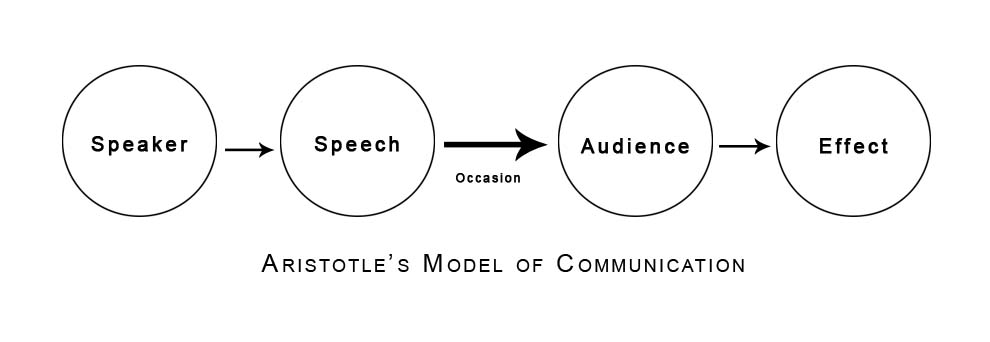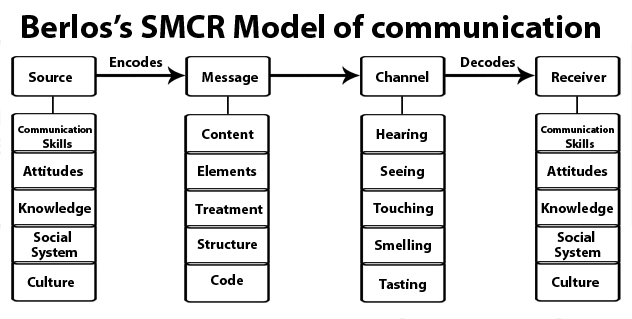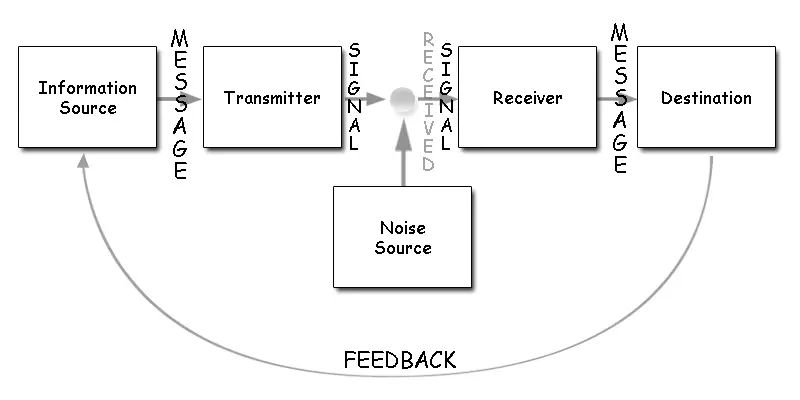A model is widely used to depict any idea, thought or a concept in a simpler way through diagrams, pictorial representations etc. Models go a long way in making the understanding of any concept easy and clear. Through a model one can easily understand a process and draw conclusions from it. In simpler words a model makes the learning simple.
The main models of communication are can be split into three categories:
- Linear models – only looks at one-way communication.
- Interactive models – looks at two-way communication.
- Transactional models – looks at two-way communication where the message gets more complex as the communication event (e.g. conversation) progresses.
BASIC MODELS OF COMMUNICATION
o Aristotle Model
o Berlo’s SMCR Model
o Shannon & Weaver Model
o Harold D. Lasswell’s Model
o Osgood & Schramm’s Model
ARISTOTLE MODEL OF COMMUNICATION:
Aristotle developed a linear model of communication for oral communication known
as Aristotle’s Model of Communication. This is considered as the first model of
communication and was proposed before 300 B.C. It is also considered to be the most widely
accepted model among all communication models. Aristotle Model is mainly focused on
speaker and speech. It can be broadly divided into 5 primary elements: Speaker, Speech,
Occasion, Audience and Effect.
The Aristotle’s communication model is a speaker centered model as the speaker has
the most important role in it and is the only one active. It is the speaker’s role to deliver a
speech to the audience. The role of the audience is passive, influenced by the speech. This
makes the communication process one way, from speaker to receiver.
The speaker must organize the speech beforehand, according to the target audience and
situation (occasion). The speech must be prepared so that the audience be persuaded or
influenced from the speech.
Example: For instance, a politician (speaker) gives a speech to get votes from the civilians
(audience) at the time of election (occasion). The civilians only vote if they are influenced by
the things the politician says in his speech so the content must be very impressive to influence
the mass and the speaker must design the message very carefully.
The speech must be clear as well as the speaker must have a very good non-verbal
communication with the audience like eye contact. This example is a classic case of Aristotle
Model of Communication depicting all the elements in the model.
Criticisms:
There is no concept of feedback, it is one way from speaker to audience.
There is no concept of communication failure like noise and barriers.
This model can only be used in public speaking.
BERLO’S SMCR MODEL OF COMMUNICATION:
In 1960, David Berlo postulated Berlo’s Sender-Message-Channel-Receiver (SMCR)
model of communication from Shannon Weaver’s Model of Communication (1949). He
described factors affecting the individual components in the communication making the
communication more efficient.
The model also focuses on encoding and decoding which happens before sender sends
the message and before receiver receives the message respectively. Berlo’s Model has mainly,
four components to describe the communication process. They are sender, message, channel
and receiver. Each of the component is affected by many factors.
Components of Berlo’s Model of Communication:
S - Sender
Sender is the source of the message or the person who originates the message. The person or
source sends the message to the receiver. The following are the factor related to sender and is
also the same in the case of receiver.
Communication Skills
Communication skills of a person is a factor that affects the communication process. If the
sender has good communication skills, the message will be communicated better than if the
sender’s communication skills are not good. Similarly, if the receiver cannot grasp the message,
then the communication will not be effective. Communication skills include the skills to speak,
present, read, write, listening, etc.
Attitude
The attitude of the sender and the receiver creates the effect of the message. The person’s
attitude towards self, the receiver and the environment changes the meaning and effect of the
message.
Knowledge
Familiarity with the subject of the message makes the communicated message have its effect
more. Knowledge on the subject matter makes the communicator send the message effectively.
Social Systems
Values, beliefs, laws, rules, religion and many other social factors affect the sender’s way of
communicating the message. It creates difference in the generation of message. Place and
situation also fall under social systems.
Culture
Cultural differences make messages different. A person from one culture might find something
offensive which is very much accepted in another culture.
M - Message
A message is the substance that is being sent by the sender to the receiver. It might be in the
form of voice, audio, text, video or other media. The key factors affecting the message are
Content
Content is the thing that is in the message. The whole message from beginning to end is the
content.
Elements
Elements are the nonverbal things that tag along with the content like gestures, signs, language,
etc.
Treatment
Treatment is the way in which the message is conveyed to the receiver. Treatment also effects
the feedback of the receiver.
Structure
The structure of the message or the way it has been structured or arranged, affects the
effectiveness of the message.
Code
Code is the form in which the message is sent. It might be in the form of language, text, video,
etc.
C-(Channel)
Channel is the medium used to send the message. In mass communication and other forms of
communication, technical machines might be used as a channel like telephone, internet, etc.
But in general communication, the five senses of a human being is the channel for the
communication flow and it affects the effectiveness of the channel.
Hearing – We receive the message through hearing.
Seeing – We perceive through seeing. We also get non-verbal messages by seeing.
Touching – Many of the non-verbal communication happens from touching like holding hands.
Smelling – We collect information from smelling.
Tasting – Taste also provides the information to be sent as a message.
R- (Receiver)
Receiver is the person who gets the message sent in the process. This model believes that the
thinking pattern and all other factors mentioned above must be in sync to that of the sender for
the communication to be effective. The message might not have the same effect as intended if
the receiver and sender are not similar. The receiver must also have a very good listening skill.
Other factors are similar to that of the sender.
Communication skills
Attitudes
Knowledge
Social Systems
Culture
Criticisms of Berlo’s SMCR Model:
There is no concept of feedback, so the effect is not considered.
There is no concept of noise or any kind of barriers in communication process.
It is a linear model of communication, there is no two way communication.
Both of the people must be similar according to all the factors mentioned above.
SHANNON WEAVER MODEL OF COMMUNICATION:
Shannon Weaver model of communication was created in 1948 when Claude Elwood
Shannon wrote an article “A Mathematical Theory of Communication” in Bell System
Technical Journal with Warren Weaver. Shannon was an American mathematician whereas
Weaver was a scientist. The Mathematical theory later came to be known as Shannon Weaver
model of communication or “mother of all models.” This model is more technological than
other linear models.
Sender (Information source) – Sender is the person who makes the message, chooses the
channel and sends the message.
Encoder (Transmitter) –Encoder is the sender who uses machine, which converts message into
signals or binary data. It might also directly refer to the machine.
Channel –Channel is the medium used to send message.
Decoder (Receiver) – Decoder is the machine used to convert signals or binary data into
message or the receiver who translates the message from signals.
Receiver (Destination) –Receiver is the person who gets the message or the place where the
message must reach. The receiver provides feedback according to the message.
Noise –Noise is the physical disturbances like environment, people, etc. which does not let the
message get to the receiver as what is sent.
The sender encodes the message and sends it to the receiver through a technological
channel like telephone and telegraph. The sender converts the message into codes
understandable to the machine. The message is sent in codes through a medium. The receiver
has to decode the message before understanding it and interpreting it. The receptor machine
can also act as a decoder in some cases. The channel can have noise and the receiver might not
have the capacity to decode which might cause problems in communication process.
Advantages of Shannon Weaver Model
Concept of noise helps in making the communication effective by removing the noise
or problem causing noise.
This model takes communication as a two way process. It makes the model applicable
in general communication.
Communication is taken as quantifiable in Shannon Weaver model.
Criticisms of Shannon Weaver Model
It can be applied more for interpersonal communication than group communication and
mass communication.
Receiver plays the passive part in the communication process as sender plays the
primary role that sends messages.
Feedback is taken as less important in comparison to the messages sent by the sender.
The model is taken by some critics as a “misleading misrepresentation of the nature of
human communication” as human communication is not mathematical in nature.
LASSWELL’S COMMUNICATION MODEL:
Lasswell’s communication model was developed by communication theorist Harold D.
Lasswell (1902-1978) in 1948. Lasswell’s model of communication (also known as action
model or linear model or one way model of communication) is regarded as one the most
influential communication models.
Lasswell’s communication model has 5 components which is used as an analysis tool
for evaluating the communication process and components. The components are the questions
to be asked to get the answers and keep communication going.
Though, generally, the component of effect was made to be more about outcome of the
message, the model is applied in different Medias and fields despite being developed
specifically for mass communication. This model is similar to the communication model
proposed by Claude Shannon and Warren Weaver. Their model is more graphical than
Lasswell’s.
Disadvantages and Criticisms of Lasswell’s Model
The major criticism of Lasswell’s Model is that it does not include feedback and it
ignores the possibility of noise.
Without feedback, a communication process cannot be fruitful.
Lasswell’s model is very linear and does not consider barriers in the communication
process.
The model is also criticized for being very general and only including very traditional
topics. The model is very simplistic.
OSGOOD AND SCHRAMM’S MODEL:
It is a Circular Model, so that communication is something circular in nature
Encoder – Who does encoding or Sends the message (message originates)
Decoder – Who receives the Message
Interpreter – Person trying to understand (analyses, perceive) or interpret
From the message starting to ending, there is an interpretation goes on. Based on this
interpretation only the message is received.
This model breaks the sender and receiver model it seems communication in a practical way.
It is not a traditional model. It can happen within our self or two people; each person acts as
both sender and receiver and hence use interpretation. It is simultaneously take place e.g.
encoding, interpret and decoding.
Semantic noise is a concept introduced here it occurs when sender and receiver apply
different meaning to the same message. It happens mostly because of words and phrases for
e.g. Technical Language, So certain words and phrases will cause you to deviate from the actual
meaning of the communication.
When semantic noise takes place decoding and interpretation becomes difficult and
people get deviated from the actual message.
Advantage of Osgood- Schramm model of communication
Dynamic model- Shows how a situation can change
It shows why redundancy is an essential part
There is no separate sender and receiver, sender and receiver is the same person
Assume communication to be circular in nature
Feedback – central feature.
Disadvantage of Osgood- Schramm model of communication
This model does not talk about semantic noise and it assume the moment of encoding and
decoding.





